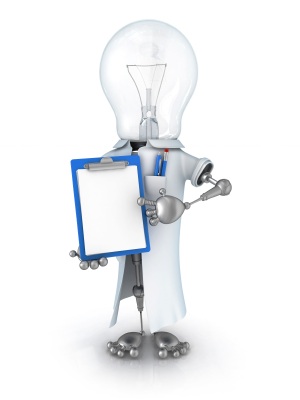A magazine where the digital world meets the real world.
On the web
- Home
- Browse by date
- Browse by topic
- Enter the maze
- Follow our blog
- Follow us on Twitter
- Resources for teachers
- Subscribe
In print
What is cs4fn?
- About us
- Contact us
- Partners
- Privacy and cookies
- Copyright and contributions
- Links to other fun sites
- Complete our questionnaire, give us feedback
Search:
Can a robot be a scientist?

Scientists use computers all the time. They use computers to help control experiments, analyse data and communicate their findings. So how about letting a computer take over all of the work?
The scientist with a built-in freezer
Computer scientists in Aberystwyth and Cambridge have made a robot scientist called Adam. Like his Biblical namesake Adam is the first of his kind, but unlike him the robot Adam doesn’t look much like his creators. Adam is an enormous box with a biology lab inside. His innards contain a freezer stocked with yeast strains, three incubators, some robot arms, a plate washer, bar code readers, cameras, twenty environmental sensors and four personal computers (among other things). He can happily run for a few days without any human intervention, though his creators advise keeping a technician handy just in case.
What’s Adam’s scientific job? Well, he’s a geneticist. His task is to find genes in yeast that encode for enzymes that act as catalysts in chemical reactions. He’s been programmed with software that contains databases of the genes and proteins he’s working on, and software to generate and test his own his own hypotheses about what genes encode for what enzymes. Adam puts his own fully-stocked lab into use, and can analyse the results himself. Based on how his experiments turn out, he can design even more to do. He can design over a thousand new experiments a day, so there’s always plenty to do. And he’s pretty good at it too – his designers think he may have found genes that encode for six chemical catalysts, including one that has puzzled researchers for fifty years.
Disputing discovery
Despite Adam’s success, though, some might argue that he’s not actually discovering anything. What really matters is that someone has programmed a question into Adam’s software in the right way, so that when left to run, it finds the answer that was lurking in the question all along. The argument that computers can’t orginate anything was first made by the very first computer programmer, Ada Lovelace. Adam’s creators acknowledge this argument, but insist there’s no doubt that new knowledge is being discovered, even if it’s being automatically generated by the robot scientist.
Robot inventors?
The arguments about whether Adam can actually discover anything aren’t just philosophical diversions. There could be lots of money tied up in it too. What happens when a robot discovers something that could be made into a product? When you invent something unique you need to get a patent on it to prevent other people copying your idea and making a profit off of it. Except what happens when a robot makes the discovery? US patent law refers only to people, not machines. What’s more, another section prevents someone getting a patent if "he did not himself invent" the thing they’re attempting to protect. Since Adam can independently make up and test hypotheses, his creators might not have any more claim to his discoveries as Bill Gates’ mum would have to her son’s billions. European robots may find the law more sympathetic though, as here we can grant patents to "bodies equivalent to a legal person". That usually means corporations, but could it mean robots in the future as well?
Teaming up
Because Adam is the first of his kind, there’s a long way to go from here. His creators are hopeful that they can improve Adam’s ability to think scientifically. It could be that in the future more and more of the scientific process will be done by robots. Robot scientists probably have a long way to go before that. Adam still needs plenty of human attention. His creators think that it will ultimately be better to have teams of robot and human scientists working together anyway. That way humans can propose new hypotheses and experiments for the robots to do. So if you have dreams of being a scientist, don’t worry – you’re a lot more likely to be working next to a robot than being replaced by one. And hey, maybe that means you get to keep the patents.


